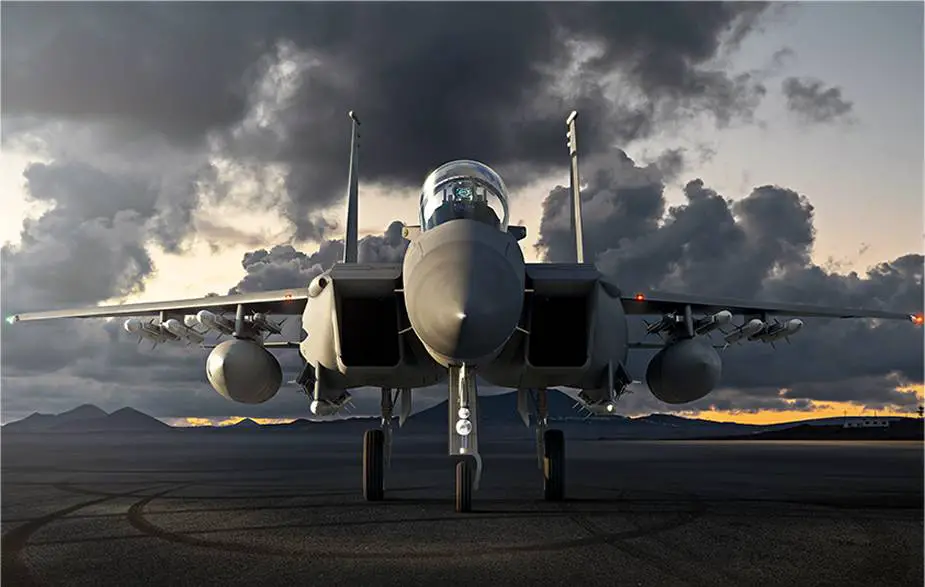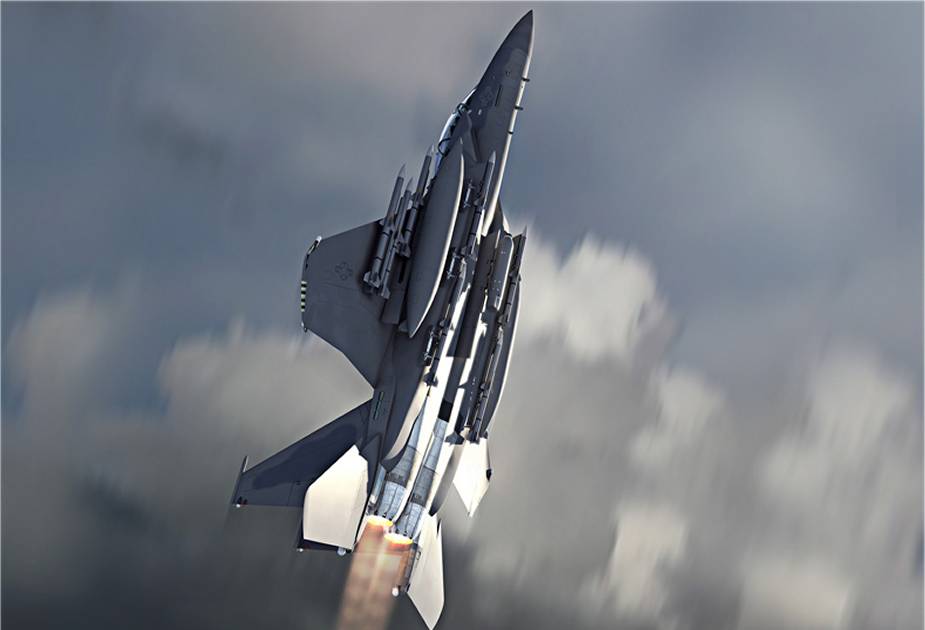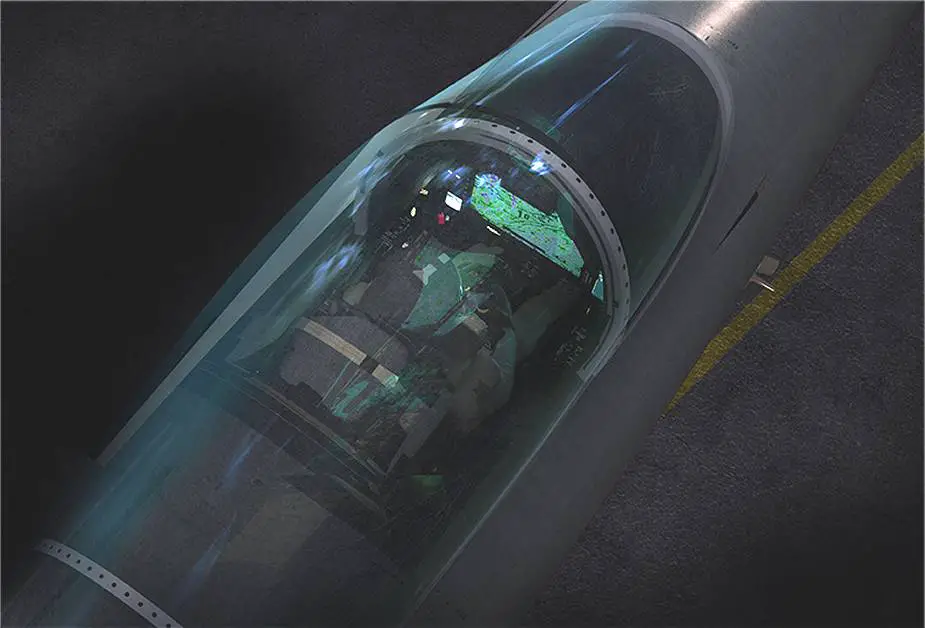Air Recognition editorial team presents a brief technical review and analysis about the F-15EX, the next generation of U.S. Air Force tactical fighter aircraft in the F-15 family that was designed by the American Company McDonnell Douglas, now part of Boeing. July 12, 2020, the U.S. Department of the Air Force awarded a nearly $1.2 billion contract for its first lot of eight F-15EX fighter aircraft.
Follow Air Recognition on Google News at this link
 Drawing of future Boeing F-15EX fighter aircraft for US Air Force. (Picture source Boeing)
Drawing of future Boeing F-15EX fighter aircraft for US Air Force. (Picture source Boeing)
The U.S. Department of the Air Force contract, awarded to Boeing, provides for the design, development, integration, manufacturing, test, verification, certification, delivery, sustainment, and modification of F-15EX aircraft, including spares, support equipment, training materials, technical data, and technical support.
The F-15 Eagle is an all-weather, extremely maneuverable, tactical fighter designed to gain and maintain air superiority in aerial combat It has electronic systems and weaponry to detect, acquire, track and attack enemy aircraft while operating in friendly or enemy-controlled airspace. The first F-15A flight was made in July 1972, and the first flight of the two-seat F-15B (formerly TF-15A) trainer was made in July 1973. The first Eagle (F-15B) was delivered in November 1974. In January 1976, the first Eagle destined for a combat squadron was delivered.
The F-15EX will replace the oldest F-15C/Ds in the service’s inventory. Eight F-15EX aircraft were approved in the fiscal year 2020 budget and 12 were requested in the FY21 budget. The U.S. Air Force plans to purchase a total of 76 F-15EX aircraft over the five-year Future Years Defense Program.£
The F-15EX is a two-seat fighter and maintains the same design as the previous version of the F-15 family with a semi-monocoque fuselage with a large-cantilever, shoulder-mounted wing. Ailerons and a simple high-lift flap are located on the trailing edge. The F-15 has a spine-mounted air brake and retractable tricycle landing gear.
The most significant difference between the F-15EX and legacy F-15s lies in its Open Mission Systems (OMS) architecture. The OMS architecture will enable the rapid insertion of the latest aircraft technologies. The F-15EX will also have fly-by-wire flight controls, a new electronic warfare system, advanced cockpit systems, and the latest mission systems and software capabilities available for legacy F-15s.

The F-15EX will be able to carry up to 22 air-to-air-missiles depending on the configuration. (Picture source Boeing)
The F-15EX will have advanced radar and sensors including a fully integrated electronic warfare suite to provide a full spectrum of protection while enabling the dominant engagement of new and emerging threats. The F-15EX is not designed as a stealth fighter, it carries munitions on the outside of the aircraft on the fuselage and wing-mounted munitions racks.
The F-15EX is fitted with the latest generation of digital cockpit providing real-time access to battlefield information and enhances the pilot's understanding of the environment to reduce workload, speed decision-making, and enhance mission management.
The F-15EX brings Open Missions Systems architecture to enable rapid digital technology insertion for future growth and provides an open secure architecture for maximum flexibility and interoperability.
The F-15EX will be powered by two F110-GE-129A engines manufactured by General Electric Aviation. In February 2020, United States Air Force Life Cycle Management Center intends to award a sole source indefinite delivery/indefinite quantity (ID/IQ) contract to General Electric Aviation to provide F110 propulsion systems to meet the F-15EX weapons system requirement. The intent is to procure and deliver F110 engines in support of the F-15EX weapon system.
The F110-GE-129 is a derivative with greater performance of the proven F110-GE-100. Due to its safety, F110-GE-129 has been chosen to power about 75% of the total F-16C/D Block 50/52 fleet (75% F-16C/D Block 50, 25% F-16C/D Block 52). F-16C/D Block 50/52 are the most advanced F-16's variants produced in the 20th century.
The F-15EX features a deep magazine that can carry a load of advanced weapons. The fighter will be able to carry up to 22 air-to-air-missiles depending on the configuration. The platform also requires minimal transitional training or additional manpower and little to no infrastructure changes, ensuring the continuation of the mission. Unrivaled weapons certification and payload permits the carriage of advanced weapons that cannot be carried in internal bays such as hypersonic weapons.
In June 2019, Raytheon and Northrop Grumman have announced that they are partnering on a new hypersonic cruise missile system that will soon undergo its first test flight. Hypersonic weapons can travel at five times the speed of sound – Mach 5 and faster – covering vast distances in minutes. The development of hypersonic missiles is a top priority for the United States armed forces.
In terms of effectiveness, the speed and altitude at which these vehicles fly significantly challenge an adversary’s ability to detect, track, target and engage. Both are key for aiding access to hostile environments, which improves the effectiveness of more conventional weapon systems.
As for speed, a hypersonic weapon traveling at rates greater than Mach 5 is flying at least a mile per second. This kind of velocity allows us to reach fleeting targets well before they getaway.

The F-15EX is fitted with the latest generation of digital cockpit providing real-time access to battlefield information. (Picture source Boeing)
















